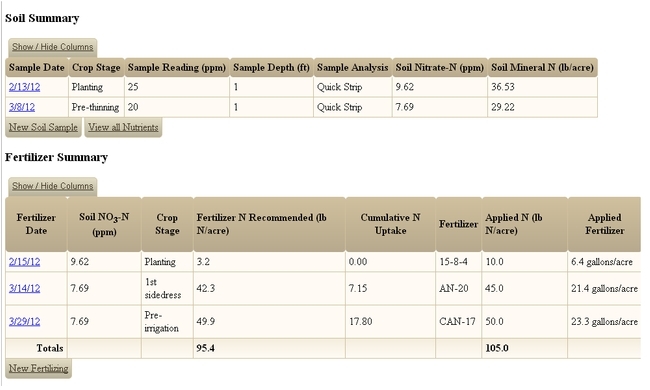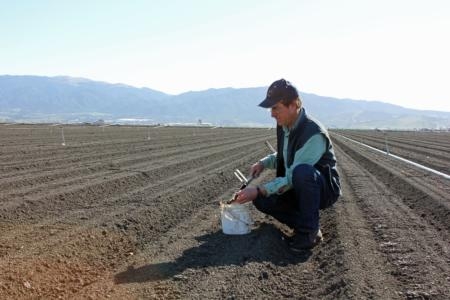Posts Tagged: Michael Cahn
Farmers and the environment profit from new UC website
UC Cooperative Extension is rolling out a new website for farmers that will help them save money and protect the environment. CropManage contains a wealth of UC research in a format that makes it easy for growers to apply to their farms.
Conceived by Michael Cahn, UCCE farm advisor in Monterey County, and programmed by the UC Agriculture and Natural Resources web team, the free website – ucanr.edu/cropmanage – allows farmers to quickly calculate the precise fertilizer and water needs of their crops.
“It’s great,” said Salvador Montes, ranch manager at Corey Ranch in the Salinas Valley, who pilot-tested the software last year on lettuce crops. “It’s very accurate in predicting the irrigation times and fertilizer (needs). It actually worked! We didn’t see any significant yield reduction using less water and fertilizer.”
By applying only the exact amount of water and fertilizer to optimize plant growth, the new website keeps farmers from using too much. Overfertilizing in the past has resulted in groundwater contamination with nitrate, a serious concern in the Salinas Valley and other farming regions. In coastal areas, overpumping wells can lead to sea water intrusion into the aquifer.
“Besides, fertilizer and water are expensive inputs,” Cahn said. “Applying more than the crop needs is like throwing money down the drain.”
On Feb. 26, Cahn will offer a mini CropManage workshop during the 2013 Irrigation and Nutrient Management Meeting at the Monterey County Agricultural Center, 1432 Abbott Street in Salinas. The meeting runs from 7:45 a.m. and concludes with a pizza lunch at 12 noon. Following lunch, the one-hour CropManage workshop begins. No reservations are required.
“Inspiration for this project,” Cahn said, “came from local growers who expressed a need for software to help them use the quick nitrate soil test and weather-based irrigation scheduling in their farming operations.”
Cahn and his colleagues, Tim Hartz, UCCE specialist in the Department of Plant Sciences at UC Davis, and Richard Smith, UCCE advisor in Monterey County, have been conducting trials for years to determine whether the combination of quick nitrogen testing and weather-based irrigation scheduling could reliably reduce the amount of nitrogen that lettuce growers apply.
“We demonstrated a 30-percent reduction in nitrogen fertilizer application,” Cahn said.
The excitement of such a significant result was tempered by the fact that implementing the research results on individual farms would require some serious math.
“When we introduced farmers to the quick nitrate test, some said they would have to hire someone to manage all the data, keep records and make decisions. I realized that we could make this a lot easier for them by programming software to do the work,” he said.
For example, farmers who wish to use weather data to schedule irrigation for lettuce must sign into CIMIS (California Irrigation Management Information Service) to request an email with reference evapo-traspiration for their locations. The data must be punched into an equation along with the irrigation coefficient for lettuce – a figure that represents how much water the lettuce needs – and the size of the lettuce canopy at the time of irrigation. This time-consuming data collection and manipulation is eliminated with CropManage.
“We’ve figured out how to facilitate all these calculations,” Cahn said.
CropManage automatically downloads the CIMIS data. The website pulls soil, crop growth and water needs information from a UC research database. The farmer goes to a simple website, names his or her fields, adds the type of irrigation systems to be used and how much water they deliver per hour.
“In effect, they set up a virtual ranch,” Cahn said.
When the farmer is ready to plant, the type of crop and results of a nitrogen quick test are added.
“The program recommends how long and when the irrigation should run and how much nitrogen, if any, should be added,” Cahn said. “The recommendations are updated automatically, taking into consideration the weather and the crop’s stage of growth.”
Throughout the growing season, farmers can monitor the progress of their farms by viewing online tables where irrigation, fertilization and growth are tracked. At any time, all the data can be downloaded as an Excel file the farmer can using for accounting or making reports.
Corey Ranch manager Montes said he accesses CropManage on a tablet computer.
“It’s very easy to use,” Montes said. “It’s easy to log on, input information and read from the tables. I love it. It’s a great tool and is definitely going to help us manage our water and fertilizer in a better way.”
Currently, CropManage contains information for production of romaine lettuce, iceberg lettuce and broccoli. Strawberries and caneberry data will be added to the system. Research is underway on leafy greens, such as spinach and baby leaf lettuce, so they also can be added.
“Everything we learn in research, we will add to CropManage,” Cahn said. “And by using it, growers can give us feedback on how accurate the system is. This is a fluid product. If growers find something that doesn’t work, we can change it.”
All the information uploaded to CropManage is held confidentially and secure on a UC server, protected with a private email address and password. The CropManage website’s privacy policy outlines setup options for users who wish to remain completely anonymous.
Development of the website was supported by a grant from the California Department of Agriculture Fertilizer Research and Education Program.
For more information about the 2013 Irrigation and Nutrient Management Meeting on Feb. 26 or about CropManage, contact Cahn at (831) 759-7377, mdcahn@ucanr.edu.
Working to achieve healthy crops while limiting nitrate in water
UC Cooperative Extension and Agricultural Experiment Station researchers are working with growers on fertilizer management, irrigation efficiency and other farming practices to provide options for protecting groundwater, which serves as a primary drinking water source for many rural communities. The following are some examples of ANR research and extension projects under way. The scientists’ names are hyperlinked to their contact information.
Quick nitrate test guides fertilizer management
Michael Cahn and Richard Smith, UC Cooperative Extension advisors in Monterey County, and Tim Hartz, UCCE specialist in the department of Plant Sciences at UC Davis, have developed a quick test to measure soil nitrate in the field so growers can match fertilizer rates with plant needs. The test has reduced nitrogen-loading rates by an average of 70 pounds per acre in lettuce. On-farm demonstration trials have shown that by testing the soil, growers can reduce their fertilizer use by about 30 percent. Major growers in Monterey County, who manage a significant number of vegetable acres in the Salinas Valley, have begun using the quick nitrate test in their operations. For more information read the summary article on p. 5 and fine tuning article on p. 12 of Crop Notes.
Assessing plant nutrient status
Leaf sampling is a common method of determining when a nut tree has a nutrient deficiency. Patrick H. Brown, professor in the Department of Plant Sciences at UC Davis and Agricultural Experiment Station pomologist, and his colleagues are studying other ways of assessing plant nutrient status to help almond and pistachio growers manage fertilizer applications with more precision. For more information, see Crop Nutrient Status and Demand.
NBOT aids dairies in nutrient planning
The Nitrogen Budget Optimization Tool (NBOT) is a planning tool being developed for dairies by David Crohn, professor and UC Cooperative Extension specialist in the Department of Environmental Sciences at UC Riverside. NBOT is an algorithm that uses a daily time step to represent crop nitrogen demand, nitrogen mineralization and losses from leaching, denitrification and ammonia volatilization. Typical nitrogen application charts tell how much nitrogen a crop needs during the growing season, but they do not say when the crop will need it. With NBOT, dairy operators input information about the crop they are growing, how much they expect to harvest and when they can apply manures. NBOT’s output gives an idealized management strategy that helps dairy operators decide what they should do all year round.
N-Ledger software addresses nitrogen management
A software program under development by a team headed by Marsha Campbell Mathews, UC Cooperative Extension advisor in Stanislaus County, will help dairy operators and other farmers improve nitrogen management by calculating when nitrogen applied in manure is expected to be released from organic form into a form that the crops can use. Nitrogen applications are tracked, release rates are estimated and adjusted for expected losses, and the calculated total is compared to the expected daily crop need for nitrogen. The program helps the user choose an application strategy that will meet the crop’s needs and result in the least possible amount of nitrate in the soil during periods when it is vulnerable to leaching or other losses. For more information, see the UC Cooperative Extension in Stanislaus County Manure Nutrient Management website.
Adjusting field length can reduce irrigation levels
In his research on how dairy operators can reduce water applications to their crops, Larry Schwankl, UC Cooperative Extension specialist at Kearney Agricultural Research and Extension Center in Parlier, has found that allowing less water to percolate will reduce impacts on groundwater. With shorter furrows, water applied per acre was cut nearly in half. In addition, manure water is often added to fresh water as part of dairy irrigation and fertigation practices, so being able to reduce the applied water also significantly reduces the amount of nitrogen applied. For more information, see Schwankl's Irrigation Management website.
UC helps dairy industry manage nitrogen on the farm
It is common practice for dairy operators to use cattle manure as fertilizer for their silage crops. UC Cooperative Extension advisors throughout California routinely provide reliable information to dairy operators and consultants so they can efficiently manage nitrogen on the farm and comply with pending state regulations. This information includes how to install and calibrate flow meters, how to measure nitrogen levels in manure ponds, how much nitrogen crops need and when they need it, and how to properly sample the crops that are harvested to know how much nitrogen is being removed. “We’ve developed protocols to ensure accurate information gathering, and we can share these with the dairy industry,” said Carol Frate, UCCE advisor in Tulare County. For more information, contact a UC Cooperative Extension dairy advisor.
To see other ANR projects and publications aimed at limiting nitrate leaching, please visit http://ucanr.edu/News/Healthy_crops,_safe_water.



